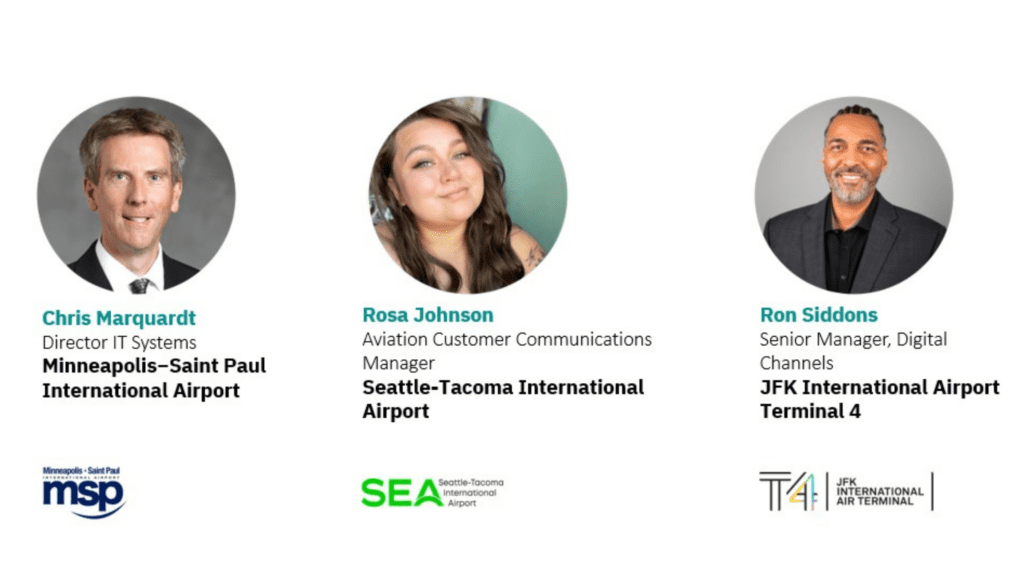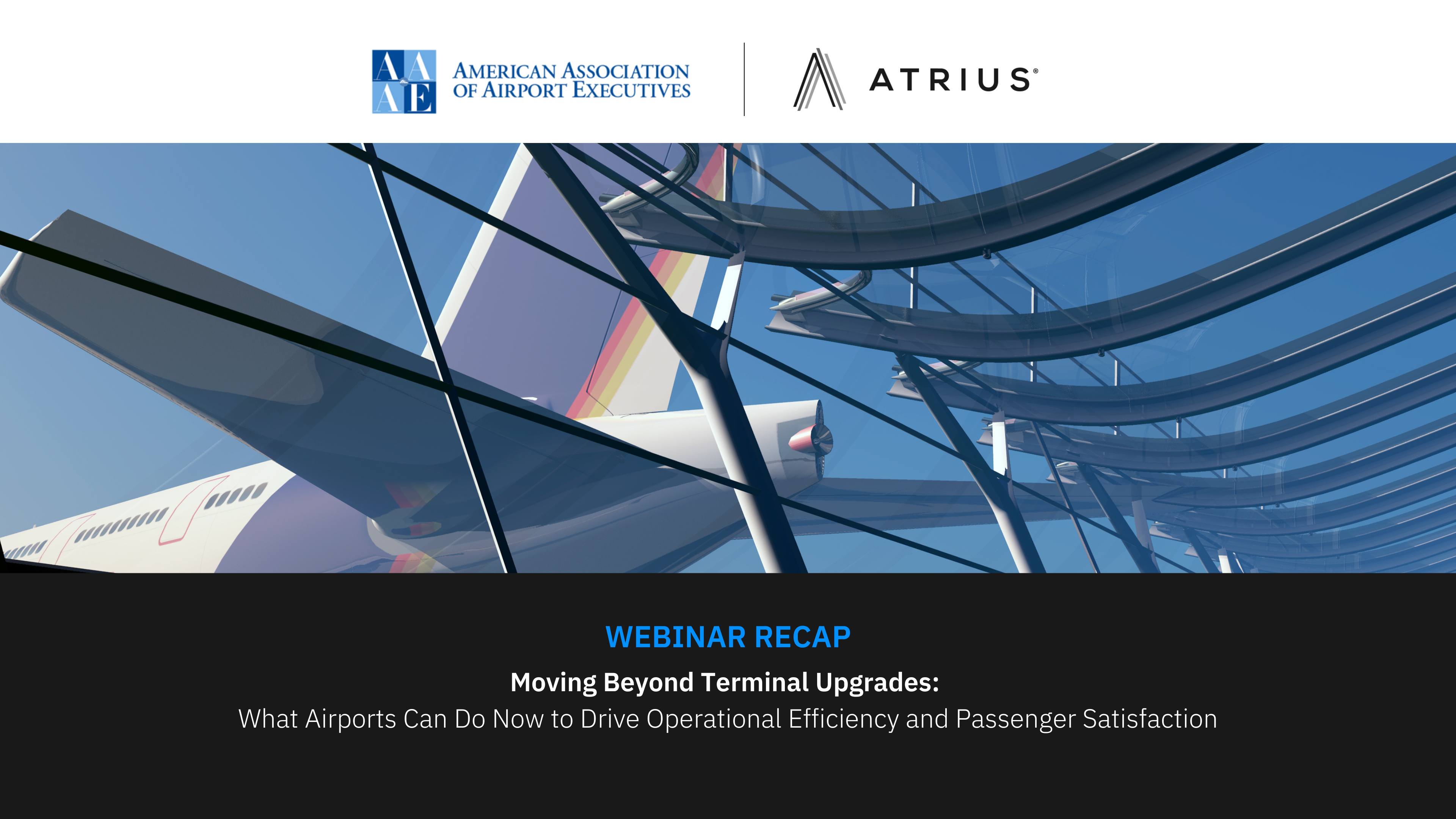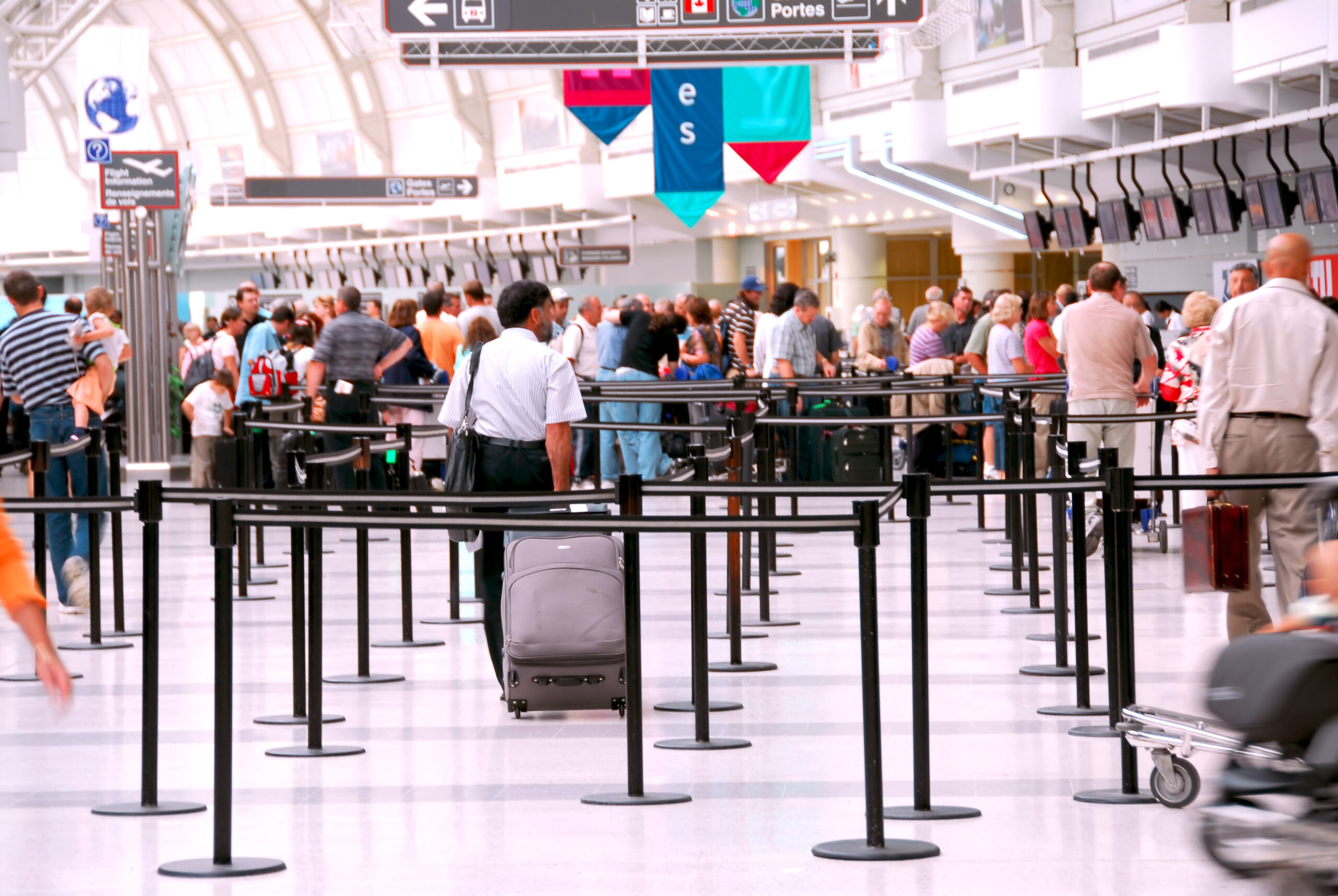Navigating through the airport can be a stressful experience. Crowds, lengthy waits at security checks, and finding departure gates in an unfamiliar area can contribute to passenger anxiety or confusion.
Thankfully, operators are proactively working to improve the day of travel experience. Co-hosted by the American Association of Airport Executives (AAAE), and Atrius®, last week’s Moving Beyond Terminal Upgrades webinar showcased three of these operators and innovators and their innovative efforts to improve passengers’ airport experience:

- Chris Marquardt, Director IT Systems, Metropolitan Airports Commission (MSP)
- Rosa Johnson, Aviation Customer Communications Manager, Seattle-Tacoma International Airport (SEA)
- Ron Siddons, Senior Manager, Digital Channels, JFK International Airport Terminal 4 (JFKT4)
Our customers are implementing data-driven decisions to enhance a wide variety of airport improvements, including but not limited to:
- Faster security lines
- Passenger-centric digital content & signage
- Smarter, highly optimized concessionaire operations
- Confident airport discovery
- Fewer gate huggers
- Improved wayfinding
Preparing passengers before check-in
Uncertainty can negatively impact passengers’ day of travel emotions, behaviors, and choices. Potential flight delays or cancellations, unfamiliarity with the facility, and navigating the overall airport experience can affect everyone differently.
Rosa Johnson, Aviation Customer Communications Manager at Seattle-Tacoma International Airport, opened our discussion by introducing SEATAC’s virtual queuing SEA Spot Saver. Launched in May 2022, the program helped reduce the unknown associated with TSA checkpoints, especially for travelers unfamiliar with SEATAC and TSA security procedures. SEATAC leaders discovered infrequent fliers are less confident about what to expect during their airport time. “It’s been wonderful for those with families, those with accessibility needs, you name it – the use cases [for Spot Saver] is really helpful for all travelers.”
SEA Spot Saver is a proven success and a big win for customers by delivering an expedited experience, especially for those who aren’t members of trusted traveler programs like TSA Pre-check or Clear. Equally exciting for fliers, operators are following SEATAC’s lead and implementing virtual queuing programs to create end-to-end passenger experiences in their airports. “Virtual queuing is really a win-win when you think about the passenger experience and operational efficiency,” explains Rosa, “and travelers ultimately spend less time waiting in line and use that time and are more likely to spend money and be at their gate on time for their flight.”
Continuing the conversation, Ron Siddons, Senior Manager, Digital Channel, JFK International Airport Terminal 4 (JFKT4), explained how JFKT4’s “4you” information on the terminal’s website helps travelers be informed prior to check-in by showcasing:
- Crucial FAQs
- Interactive maps
- Flight details
- Safety tips
- Where to shop, dine, and relax before departure
Operators giving passengers straightforward, advanced access to airport information are building better day of travel experiences. The opportunity to replace uncertainty with confidence means happier passengers spending more money at airport concessionaires. Whether they’re planning ahead from their desk at home or mobile device in the Uber headed to the airport, committing to better-informed passengers is crucial to delivering superior customer experiences.
“It is a continuous learning opportunity to evolve and grow and make adjustments”.
Ron Siddons, Senior Manager, Digital Channels, JFK International Airport Terminal 4 (JFKT4)

Improving the customer journey with assurance and confidence
In 2021, Minneapolis−Saint Paul International Airport (MSP) served over 25 million passengers. Chris Marquardt, Director IT Systems at MSP, described how they’re using real-time digital signage and interactive digital displays to facilitate smoother navigation for frequent and first-time MSP passengers.

Chris offered examples of using digital signage and interactive displays to reduce passenger anxiety about missing flights, getting lost, or not knowing where to claim their luggage. Additionally, he emphasized the importance of showcasing airport amenities, shopping, and dining options, including showing accurate opening hours. Real-time information discourages “gate huggers” by enabling people to decide how much of the terminal (or beyond) they can explore and quickly return to the gate in time for boarding.
The right digital signage makes travelers’ airport experiences more efficient and enjoyable. Dynamic and visually appealing designs elevate a necessary communication system to engaging and entertaining screens people rely on for up-to-the-minute information as they navigate the airport.
“Staffing our concessionaires is a pinpoint for us, and by showing analyzing foot traffic, data helped us bridge that gap and enabled concessionaries to optimize staffing.”
Chris Marquardt, Director IT Systems, Minneapolis−Saint Paul International Airport
Tailoring airport experiences with data insights
Deep data insights regarding traveler needs and preferences are essential for operations like JFKT4, MSP, and SEATAC to remain competitive. Delivering superior, tailored customer experiences means powering operational decisions with data and trends.
For example, MSP concessionaires receive passenger flow and wait-time data to optimize storefront displays and open hours. Similarly, JFKT4 strengthens relationships with TSA by sharing data insights related to security checkpoints. Ron explains, “With our modeling capabilities, we can also offer suggestions like which lanes they should have open, making their jobs a lot easier, which creates a great relationship with our local TSA.”
SEATAC also uses its passenger flow data to help alleviate bottlenecks and wait times at TSA security checkpoints. Supplying TSA with real-time insights “is not only helpful for the passengers for them to see what time to get there, how much time they are saving, where to be and when…this has also been helpful for our staff as well by being able to know the predictability and flow of our checkpoints,” explained Johnson.
Finding superior customer experiences beyond terminal upgrades
Carter Morris, Executive VP at AAAE, and our panelists, on behalf of Atrius, please accept my genuine appreciation for making this webinar insightful and practical. Also, to our attendees, thank you for recognizing the value of joining us today. View the full webinar here.
Atrius Wayfinder supports airports like JFKT4, MSP, and SEATAC to collect and analyze data that, in turn, elevate their customers’ day of travel while streamlining operations. Proven benefits of implementing Atrius technology to shape qualitative-based decisions and transmit real-time information to airport employees, airlines, and travelers include:
- Superior travel and work environments
- Frictionless touchpoints along their day of travel journey, from arriving at the airport to boarding the plane
- Increasing non-aeronautical revenue from powerful contextual search features, rich POI data, and intuitive maps
- A single source of truth to modify and collaborate on map and venue data with seamless deployment across all channels
- Essential updates for concession information, including locations, open hours, and contactless services
- Standardized indoor mapping solutions across web, mobile, and native applications
- Unlocking insights about how people move throughout your airport
- Achieve your ambitious sustainability goals
Analyzing traveler feedback is reshaping the entire airport ecosystem. Whether you’re ready to realize one or all these benefits, Atrius is ready for you. Start today.



